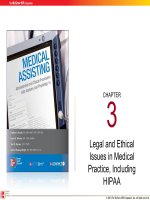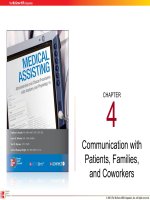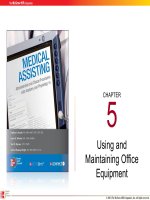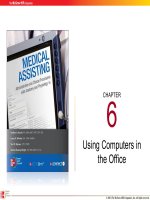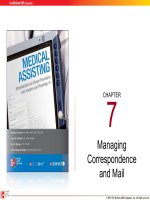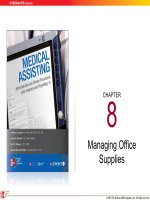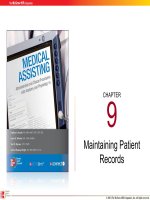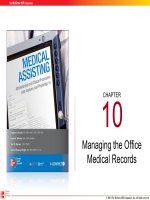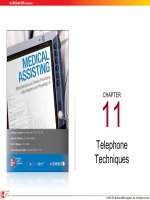Lecture Medical assisting: Administrative and clinical procedures with anatomy and physiology (4/e) – Chapter 30
Bạn đang xem bản rút gọn của tài liệu. Xem và tải ngay bản đầy đủ của tài liệu tại đây (953.92 KB, 45 trang )
CHAPTER
30
The Endocrine
System
© 2011 The McGraw-Hill Companies, Inc. All rights reserved.
302
Learning Outcomes
30.1 Define the term endocrine glands.
30.2 Describe the general functions of the
endocrine system.
30.3 Define the term hormone.
30.4 Explain the difference in hormone control by
positive and negative feedback loops.
© 2011 The McGraw-Hill Companies, Inc. All rights reserved.
303
Learning Outcomes (cont.)
30.5 Describe the locations of the hypothalamus,
pituitary gland, pineal body, thyroid gland,
parathyroid glands, adrenal glands,
pancreas, thymus, and gonads.
30.6 List the hormones released by the pituitary
gland and give the functions of each.
30.7 List the hormones released by the thyroid
gland and parathyroid glands and give the
functions of each.
© 2011 The McGraw-Hill Companies, Inc. All rights reserved.
304
Learning Outcomes (cont.)
30.8 List the hormones released by the adrenal
glands and give the functions of each.
30.9 List the names of the endocrine cells of the
pancreas, the hormones released by them,
and the function of each hormone.
30.10 List the hormones released by the pineal
body, thymus, and gonads, and give the
functions of each.
© 2011 The McGraw-Hill Companies, Inc. All rights reserved.
305
Learning Outcomes (cont.)
30.11 Name the hormones produced by the
kidneys and heart, listing which organ
produces the hormone, and the hormone’s
function.
30.12 Describe stressors and their effect on the
body.
30.13 Describe the causes, signs and symptoms,
and treatment of various endocrine
disorders.
© 2011 The McGraw-Hill Companies, Inc. All rights reserved.
306
Introduction
• The endocrine system includes the organs of the
body that secrete hormones directly into body
fluids such as blood
– Regulates chemical reaction in cells and therefore
control functions of the organs, tissues, and other
cells
bloodstream
t
in
Glands
o
to
secrete
hormones
target tissues
© 2011 The McGraw-Hill Companies, Inc. All rights reserved.
307
Hormones
• Endocrine glands
– Ductless
– Release hormones
• Directly into target tissues
• Into bloodstream to be carried to target tissues
• Hormones – chemicals secreted by a cell
that affect the functions of other cells
© 2011 The McGraw-Hill Companies, Inc. All rights reserved.
308
Hormones (cont.)
• Many are derived from steroids that easily
cross the cell membrane
• Examples of steroidal hormones
– Estrogen
– Progesterone
– Testosterone
– Cortisol
Hormones
© 2011 The McGraw-Hill Companies, Inc. All rights reserved.
309
Hormones (cont.)
• Nonsteroidal hormones
– Made of amino acids or
proteins and cannot cross
the cell membrane easily
– Bind to receptors on the
surface of the cells
– G-protein – activated by
the hormone-receptor
complex
• Activates enzymes inside
cell
• Prostaglandins
– Local, or tissue, hormones
– Derived from lipid
molecules
– Do not travel in the
bloodstream
– Target tissues are located
close by
– Produced by organs such
as
•
•
•
•
•
Kidneys
Heart
Stomach
Uterus
Brain
© 2011 The McGraw-Hill Companies, Inc. All rights reserved.
3010
Feedback Loops
• Control hormone levels
• Negative feedback loop
– Hormone release stops in response to
decrease in stimulus
• Stimulus (eating) raises blood glucose levels
• Pancreas releases insulin in response to elevated
blood glucose
• Blood glucose decreases as it is used by the body
or stored in the liver
• Insulin release stops as blood glucose levels
normalize
© 2011 The McGraw-Hill Companies, Inc. All rights reserved.
3011
Feedback Loops (cont.)
• Positive feedback loop
– As long as stimulus is present, action of
hormone continues
• Infant nursing at mother’s breast stimulates
hypothalamus stimulates posterior pituitary
• Oxytocin released stimulates milk production
and ejection from mammary glands
• Milk release continues as long as infant continues
to nurse
© 2011 The McGraw-Hill Companies, Inc. All rights reserved.
3012
Apply Your Knowledge
Match the following:
ANSWER:
E Chemicals that effect cell function
___
A. Nonsteroidal hormone
B Easily cross cell membranes
___
B. Steroidal hormone
A Made of amino acids
___
C. G-protein
D Target nearby cells
___
D. Prostaglandins
C Activated by hormone-receptor
___
complex
E. Hormones
A Cannot cross cell membranes easily
___
B Estrogen and cortisol
___
© 2011 The McGraw-Hill Companies, Inc. All rights reserved.
3013
Hypothalamus
• Hormones
– Oxytocin
– Antidiuretic hormone (ADH)
• Hormones transported to the posterior
pituitary for storage
• Directs posterior pituitary to release
hormones
Glands
© 2011 The McGraw-Hill Companies, Inc. All rights reserved.
3014
Pituitary Gland
• Controlled by the hypothalamus
• Located at the base of the brain
– Protected by a bony structure called the sella turcica
– The optic chiasm is located just above the pituitary
gland
• Carries visual information to the brain for interpretation
• Two lobes
– Anterior lobe
– Posterior lobe
Pituitary
Gland
Glands
© 2011 The McGraw-Hill Companies, Inc. All rights reserved.
3015
Pituitary Gland (cont.)
Prolactin Stimulates milk
Growth hormone
Stimulates increase in size
of muscles and bones
Luteinizing
production
Anterior
Lobe
Females: stimulates ovulation
and estrogen production
Males: stimulates testosterone production
Adrenocorticotropic (ACTH)
Stimulates the adrenal cortex
to release its hormones
Thyroidstimulating
(TSH)
Stimulates the thyroid
gland to release its
hormones
Folliclestimulating
Females: stimulates estrogen
production and maturation of the ova
Males: stimulates sperm production
© 2011 The McGraw-Hill Companies, Inc. All rights reserved.
3016
Pituitary Gland (cont.)
Posterior
Lobe
Antidiuretic hormone (ADH)
Stimulates the kidneys to
conserve water
Oxytocin
Females: causes
contraction of the uterus
and ejection of breast
milk
Males: stimulates
contraction of the
prostate and vas
deferens during sexual
arousal
© 2011 The McGraw-Hill Companies, Inc. All rights reserved.
3017
Apply Your Knowledge
Match the following:
ANSWER:
D,
E Stored in posterior pituitary
___
A. Follicle-stimulating hormone
B Milk production
___
B. Prolactin
D,
E Produced by hypothalamus
___
C. Luteinizing hormone
A Stimulates sperm production
___
D. ADH
A Maturation of ova
___
E. Oxytocin
C Stimulates ovulation
___
D Conservation of water
___
C Production of testosterone
___
E Contraction of uterus
___
Super!
© 2011 The McGraw-Hill Companies, Inc. All rights reserved.
3018
Thyroid Gland
Located below the larynx
Divided into follicles that store some of the hormones
Major hormones
T3 T4
Stimulate protein synthesis and
increase cellular energy
production
Lowers blood calcium levels by
activating osteoblasts that build
new bone tissue
Glands
© 2011 The McGraw-Hill Companies, Inc. All rights reserved.
3019
Parathyroid Glands
• Four located on the posterior surface of
the thyroid gland
• Secrete parathyroid hormone (PTH)
– Agonist to calcitonin by raising blood calcium
levels through activation of osteoclasts
(dissolve bone)
• As bone dissolves, calcium levels in blood
increase
Glands
© 2011 The McGraw-Hill Companies, Inc. All rights reserved.
3020
Apply Your Knowledge
True or False:
ANSWER:
T Thyroid hormones stimulate protein synthesis.
__
F The thyroid gland does not store hormones.
__
F PTH activates osteoblasts.
__
Thyroid follicles store
some hormones.
PTH activates osteoclasts.
F Calcitonin increases cellular energy production.
__
Thyroid hormone
increases cellular
energy production.
T The four parathyroid glands are located on the thyroid gland.
__
T Calcitonin lowers blood calcium levels.
__
© 2011 The McGraw-Hill Companies, Inc. All rights reserved.
3021
Adrenal Glands
• Located on top of each kidney
• Divided into the adrenal medulla and
adrenal cortex
• Adrenal medulla
– Central portion
– Hormones
• Epinephrine
• Norepinephrine
• Same effects as sympathetic nervous
system
Glands
© 2011 The McGraw-Hill Companies, Inc. All rights reserved.
3022
Adrenal Glands (cont.)
• Adrenal cortex
– Outermost portion
– Secretes many hormones, but main ones are
• Aldosterone
– Stimulates body to retain sodium and water
– Important in maintaining BP
• Cortisol
– Released when stressed
– Decreases protein synthesis, resulting in slowed tissue
repair
– Decreases inflammation
© 2011 The McGraw-Hill Companies, Inc. All rights reserved.
3023
Apply Your Knowledge
Match the following:
ANSWER:
B, D Adrenal medulla
____
A. Cortisol
C
____
Sodium retention
B. Epinephrine
A
____
Decreases inflammation
C. Aldosterone
B, D Sympathetic effects
____
D. Norepinephrine
C
____
Maintains blood pressure
A
____
Released during stress
A, C
____
Adrenal cortex
Excellent!
© 2011 The McGraw-Hill Companies, Inc. All rights reserved.
3024
Pancreas
• Located behind the
stomach
• Both exocrine gland and
endocrine gland
– Exocrine – secretes
digestive enzymes into a
duct leading to the small
intestine
– Endocrine – secretes
hormones into
bloodstream
Glands
© 2011 The McGraw-Hill Companies, Inc. All rights reserved.
3025
Pancreas (cont.)
• Islets of Langerhans secrete hormones into
bloodstream
– Alpha cells secrete glucagon
– Beta cells secrete insulin
Blood glucose
concentrations
Protein synthesis
Blood glucose
concentrations
Protein synthesis
© 2011 The McGraw-Hill Companies, Inc. All rights reserved.

